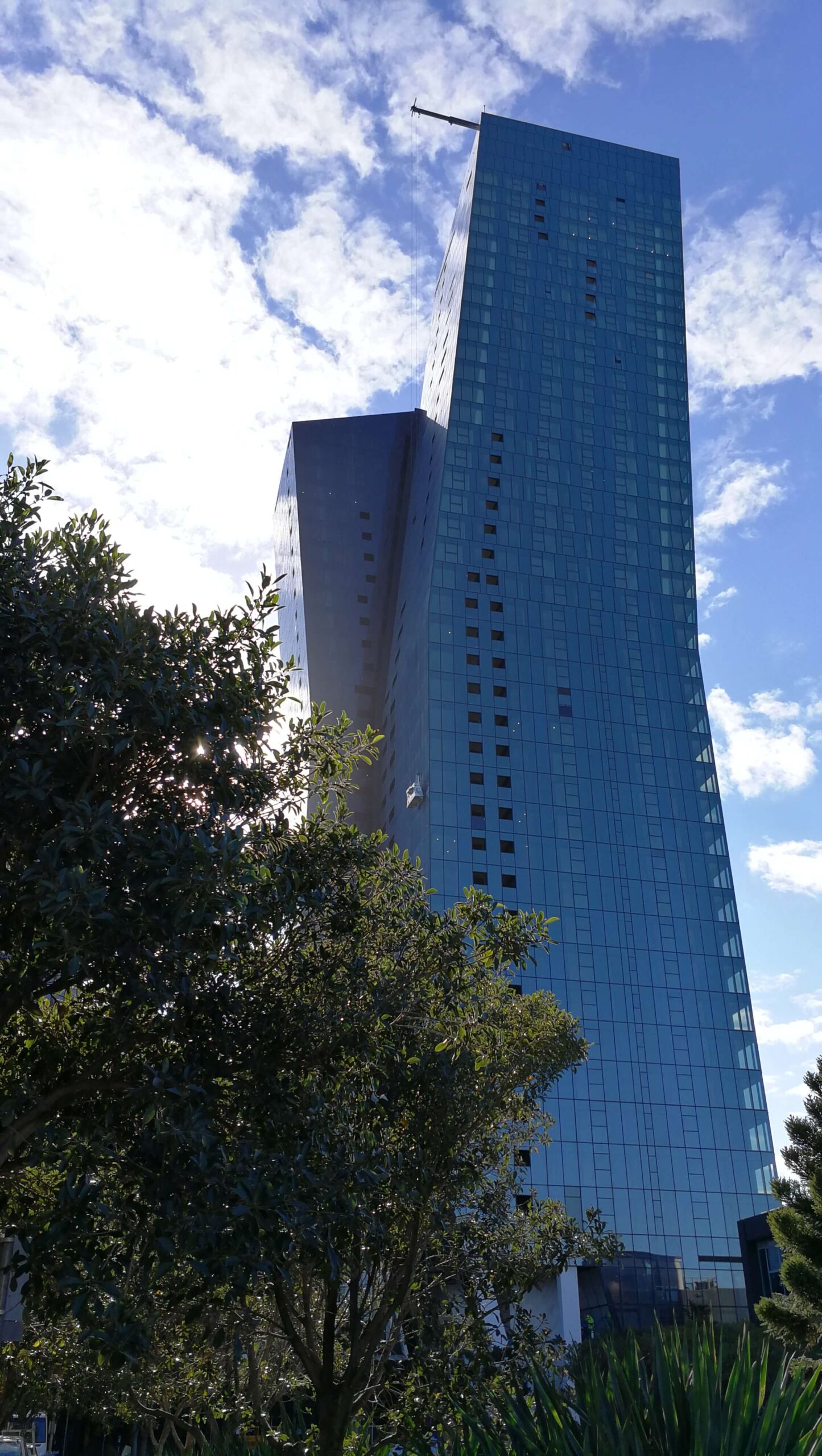Regular window cleaning is proven to have a positive impact on your business. The brightness of a building and a clear view from office floors indicate a business that is intelligent and in good health. Besides a professional look, clean windows also add to customer confidence and value in a company.
To ensure a clean looking facade at all times, we advise our clients to think of fitting cleaning cycle for their building before choosing a facade access solutions. In other words: how often and long does it take to get an entire building’s facade cleaned?
In this articlet we will take a more in-depth look at how a cleaning cycle is calculated based on a specific project.
Setting up a cleaningcycle
First off, lets state that a pre-calculated cleaning cycle is always an estimate based on technical assumptions. Actual cleaning times can differ from the calculation due various circumstances.
The calculation of a cleaning cycle isn’t a standard procedure for many manufactures of facade access equipment. It is either requested by the client on beforehand (for example, they can request a certain amount of cleaning cycles per year) or the cycle is calculated in a later design phase of the access solution to verify the amount of cleaning time.
A cleaning cycle is calculated based on a number of factors which vary per maintenance solution. For creating the calculated cycle we assume a solution with one (permanent) roof car installed at the top level of the building.

Do the math
As mentioned, we start with investigating the buildings drawings and calculate the number of square meters (or square feet) of glass panels that need to be cleaned. For this particular project we calculated approximately 40 500 m2 (435 938 ft2) of glass panels on a 350+ meter (1150+ feet) high skyscraper.
Now that we know the amount of glass we need to calculate for cleaning, it is time to take a look at the technical capacity of the BMU; what is the hoisting speed* of the unit and how long does it take to make a single drop? And more important, how does this time influence the time of work that window washers need to take into mind.
* Maximum speed of vertical movement of the platform or cradle.


Roof car speed
The average roof car cradle travels at a speed of 12 meters per minute (39 feet per minute) and needs to be anchored to a restraint system every 12 to 20 meters (approx. 39 to 66 feet) – depending on the standards that local authorities state. Bringing the total number of restraint levels for this specific project to 16 – taking into account that for every restraint level the users need to take a minute and a half to attach the cradle to the restraint anchor.
If we look at the technical information above and combine this with the height of this building we can conclude that it would take approximately 54 minutes for the cradle to make one full drop – one drop consists of a single travel movement from the top of the building to approximately ground level. This includes the amount of time that has to be taken to restraint the cradle and is without performing any form of work along the way.
Based on the height of the building and the glass surfaces of all facades combined, it is estimated that a total of 74 drops will be needed to cover the entire building. Making up for a total drop time of 7992 minutes (74 drops x 54 minutes x 2 for up and down).
The workers
The next step in the calculation is to look at the personnel that will perform the cleaning. When making a first calculation we assume that the work will be done by two window washers inside the cradle, each responsible for approximately 50 m2 (538 ft2) of cleaning per hour.
Bringing the total of cleaning capacity to approximately 100 m2 (1076 ft2) per hour for this single BMU. Weather conditions play an important role in these numbers. Window washers can cover more facade surface in a cradle that hangs in a stable position than when they have to work in for example windy conditions.
For countries or certain areas with more windy conditions, we calculate with an adjusted cleaning rate of approximately 40 m2 (430 ft2) per worker per hour.

The results
Once we take all the necessary building and technical information is gathered we can calculate a final sum up for our cleaning cycle
- A standard work day means 8 hours per day.
With a single roof car operated by two window washers it should take approximately 405 hours to clean all glass facades, this is calculated as followed:
- A total of 40 5000 m2 of glass surface divided by the total cleaning rate of 100 m2 per hour. Meaning that after 50,6 days of work the building should be completely clean. But with this simple calculation the cleaning cycle is not finished yet.
- Because the workers can’t clean all windows at once, we need combine the data above with the calculations we’ve made regarding number of drops and time each drop takes including restraint time. The total of 74 drops (up and down) would take approximately 7992 minutes, which is 133,2 hours.
- This makes up for a total of 16,7 working days of operation time.
When we add up these numbers you get a total time of cleaning of 67,3 days. But, this is not the final number yet. We need to add one more aspect of the works to this. Each day of work the assigned workers need to deploy the BMU before starting their work and park or store the unit when finished. For this we take an average of 10 minutes per time they perform an action. Making that for the 67,3 working days mentioned above it will take them approximately another 3 days in total to start/end their work with the roof car. After adding this up to the total it will bring the amount of needed time to 70,3 working days.
In conclusion, it will take workers around 71 working days to clean the all glass surfaces of this building.
* Please note that all work and machine-related numbers may deviate from reality because for this calculation we assume ideal (weather) conditions while performing the work. Calculations based on for example windy weather conditions can be performed but will significantly increase the amount of time it takes to clean a building.
Reducation of cleaning time
As mentioned before it could be that a client comes with a certain demand when it comes to a cleaning cycle. For example, they demand that the building needs to be entirely maintained 3 times a year and that the work performed may not take more than 4 weeks in a row (approx. 40 working days).
If you look at the numbers we calculated for the project above, it would mean that this does not fit the client expectations. There are several options which could be taken into account to reduce the total time of cleaning.
At first, the client could consider a second (identical) roof car to reduce the cleaning time by 50% when both BMUs are operating at the same time.
To consider this option the client needs to realize that this does not only mean nearly double the costs for manufacturing the facade access equipment, but also will cost double the man power (and hours) to perform facade maintenance.
A second option, one we see a lot in practice, is to equip the BMU with a larger/wider type of cradle. This way the cradle will cover more facade surface with one drop and so will reduce the total number of drops.
Meaning there is less time necessary to have the roof car in operation.
Dowload the infographic
For your convenience we have created a poster which gives a visual presentation of how a cleaning cycle is calculated.
Download the free poster here and learn more about our Facadexs solutions and methods.

